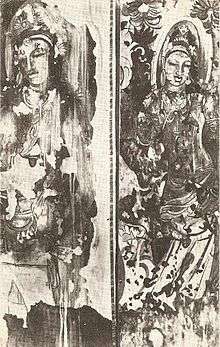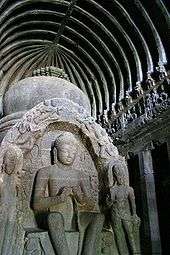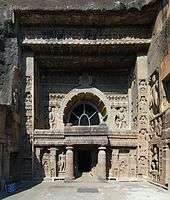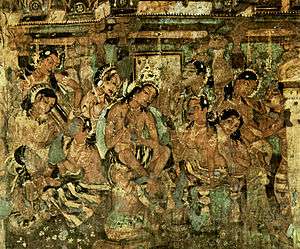Bagh Caves
The Bagh Caves are a group of nine rock-cut monuments, situated among the southern slopes of the Vindhyas in Bagh town of Dhar district in Madhya Pradesh state in central India.[1] These monuments are located at a distance of 97 km from Dhar town. These are renowned for mural paintings by master painters of ancient India. The use of the word "cave" is a bit of a misnomer, since these are not natural, but instead examples of Indian rock-cut architecture. The Bagh caves, like those at Ajanta, were excavated by master craftsmen on perpendicular sandstone rock face of a hill on the far bank of a seasonal stream, the Baghani. Buddhist in inspiration, of the nine caves, only five have survived. All of them are 'viharas' or resting places of monksmonasteries having quadrangular plan. A small chamber, usually at the back, forms the 'chaitya', the prayer hall. Most significant of these five extant caves is the Cave 4, commonly known as the Rang Mahal (Palace of Colors). These caves were dug out by Savannah. These were quarried in 5th -6th century AD.
The paintings



The paintings on the wall and ceilings of the viharas of Bagh, the fragments of which are still visible in Cave 3 and Cave 4 (remnants seen also in Caves 2, 5 and 7), were executed in tempera. These paintings are materialistic rather than spiritualistic.The ground prepared was a reddish-brown gritty and thick mud plaster, laid out on the walls and ceilings. Over the plaster, lime-priming was done, on which these paintings were executed. Some of the most beautiful paintings were on the walls of the portico of Cave 4. To prevent further loss of the values of Indian classical art, most paintings were carefully removed in 1982 and today can be seen in Archaeological Museum of Gwalior.[2]
Date
An copperplate inscription of Maharaja Subandhu, recording his donation for the repair of the vihara was found at the site of Cave 2. Though, the date of the Bagh inscription is missing, his Badwani copperplate inscription is dated in the year (Gupta era) 167 (487). So the repair of Cave 2 took place in the late 5th century.[3]
See also
| Wikimedia Commons has media related to Buddhist Caves No.1 to 7 in Bagh. |
Notes
- ↑ http://dhar.nic.in/visit.htm#tab=1
- ↑ "Bagh Caves – rock cut Buddhist temples". Retrieved 23 April 2010.
- ↑ Verma, Archana (2007). Cultural and Visual Flux at Early Historical Bagh in Central India, Oxford: Archaeopress, ISBN 978-1-4073-0151-8, p.19
Further reading
- Pande, Anuapa (2002). The Buddhist Cave Paintings of Bagh, New Delhi: Aryan Books International, ISBN 81-7305-218-2, sumit vyas
Coordinates: 22°19′21.63″N 74°48′22.36″E / 22.3226750°N 74.8062111°E



